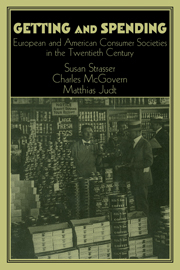Book contents
- Frontmatter
- Introduction
- Part One Politics, Markets, and the State
- Part Two Everyday Life
- 9 World War I and the Creation of Desire for Automobiles in Germany
- 10 Gender, Generation, and Consumption in the United States: Working-Class Families in the Interwar Period
- 11 Comparing Apples and Oranges: Housewives and the Politics of Consumption in Interwar Germany
- 12 “The Convenience Is Out of This World”: The Garbage Disposer and American Consumer Culture
- 13 Consumer Culture in the GDR, or How the Struggle for Antimodernity Was Lost on the Battleground of Consumer Culture
- 14 Changes in Consumption as Social Practice in West Germany During the 1950s
- 15 Reshaping Shopping Environments: The Competition Between the City of Boston and Its Suburbs
- 16 Toys, Socialization, and the Commodification of Play
- 17 The “Syndrome of the 1950s” in Switzerland: Cheap Energy, Mass Consumption, and the Environment
- 18 Reflecting on Ethnic Imagery in the Landscape of Commerce, 1945-1975
- Part Three History and Theory
- Index
16 - Toys, Socialization, and the Commodification of Play
Published online by Cambridge University Press: 05 January 2013
- Frontmatter
- Introduction
- Part One Politics, Markets, and the State
- Part Two Everyday Life
- 9 World War I and the Creation of Desire for Automobiles in Germany
- 10 Gender, Generation, and Consumption in the United States: Working-Class Families in the Interwar Period
- 11 Comparing Apples and Oranges: Housewives and the Politics of Consumption in Interwar Germany
- 12 “The Convenience Is Out of This World”: The Garbage Disposer and American Consumer Culture
- 13 Consumer Culture in the GDR, or How the Struggle for Antimodernity Was Lost on the Battleground of Consumer Culture
- 14 Changes in Consumption as Social Practice in West Germany During the 1950s
- 15 Reshaping Shopping Environments: The Competition Between the City of Boston and Its Suburbs
- 16 Toys, Socialization, and the Commodification of Play
- 17 The “Syndrome of the 1950s” in Switzerland: Cheap Energy, Mass Consumption, and the Environment
- 18 Reflecting on Ethnic Imagery in the Landscape of Commerce, 1945-1975
- Part Three History and Theory
- Index
Summary
play ascendant
“Culture arises in the form of play,” claimed Johan Huizinga, who celebrated play for that transcendent spirit of human creativity “which accomplishes itself outside and above the necessities and seriousness of everyday life.” The dynamics of contemporary consumerism are similarly characterized by the rapid opening of leisure activities that accompanies the “shift in the derivation of social meaning from the public world of production to a more private world of buying, using and imagining - rather than making - goods.” The “postmodern” culture of consumption, argues Baudrillard, therefore marks a radical rupture with the prior modernist valorizations of rationality, utility, and hard work because consumerism overturns the universalized conception of needs and with it the craft, instrumentalist, and pragmatic relationships to goods that held sway in the modernist era. Especially in the postwar period, amplified by the explosion of commercial communication media, the “free play” of consumerism seemed increasingly to define all aspects of social life, dissolving reality in a swirl of fantastic commodity signs. In the consumer culture “symbolic play” seems to have become the dominant mode of consumption.
The reference to play, however metaphoric, is not incidental. Few scenes conjure the symbolic dynamics of postmodern consumer culture as readily as the image of the contemporary child alone in his or her room fantasizing with dolls or absorbed in the imaginary world of video games.
- Type
- Chapter
- Information
- Getting and SpendingEuropean and American Consumer Societies in the Twentieth Century, pp. 339 - 358Publisher: Cambridge University PressPrint publication year: 1998
- 3
- Cited by



